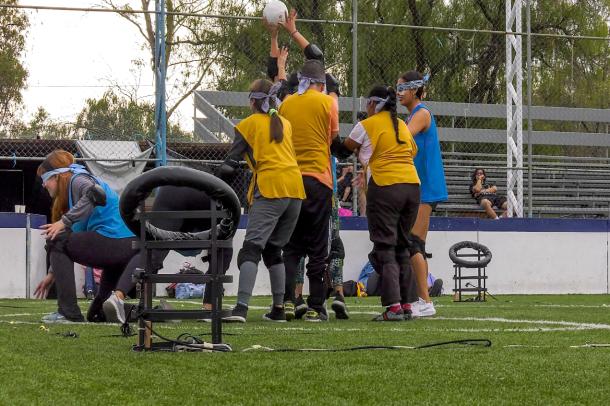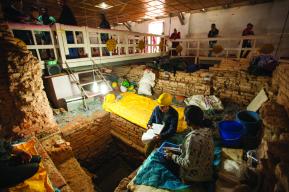Practising a sport without being able to see is a reality for some people, who can enjoy it even if the options are fewer. For Irma Nallely Baltazar, playing without seeing has a special spark to break down divisions and barriers to starting or persisting in sports practice.
Sport is a human right, and if we recognise it, it is possible to make it accessible for all people, Irma commented, one of the five students from the University of Guanajuato (UG) who created Tiro en Braille, a Mexican game in which men and women, people with and without disabilities (conventional), can play simultaneously without categories or divisions.
Most of the children in Mexico received physical education lessons from elementary to junior high school. Still, Irma had not felt identified or involved until she had the opportunity to play and create a completely inclusive sport in higher education.

People play Tiro en Braille blind, guided by listening, and must put specially designed balls into baskets on the ground to accumulate points. The game hypothesis is that blind and partially sighted persons would participate without competitive disadvantage compared to normative sighted people, who must blindfold themselves; that it should be economically accessible, with few accessories for its replicability, low environmental impact, and even incorporate elements from the traditional ball game of indigenous peoples of Mexico.
The process made her rethink sports as a tool to socialise, exercise analytical thinking, and explore and strengthen physical abilities and socio-emotional skills based on each corporality and reality of the people.
Daniel Añorve, a professor at UG, called his group from the elective subject International Relations in 2019 to voluntarily create a sport that everyone could play, with a human rights perspective, and aligned with the UN's Sustainable Development Goals. That's how José Pablo Fuentes, Axel Adrián Jiménez, María Fernanda Lara, and Irma, students of BA in Law, and Dulce Rivera from the BA in Public Administration, designed Tiro en Braille.

The initiative is improved continually as a member project of the UG's Learning Unit (through the International Relations Seminar), which promotes student initiatives linked to teaching and scientific research, explained Daniel Añorve.
For example, the first tournament was developed in 2022 on a 5x8 meter cement court, with a duration of 30 minutes per game. The second was in 2023, on a 6x10 meters grass court, with two halves of 20 minutes, penalty shots were implemented and baskets and balls were improved. For the third edition in 2024, a square grass court of 10x10 meters is planned, with a significant reduction in physical contact between participants to protect the integrity of those involved.

The students had the academic advisory of Francisco Mora Sifuentes and the steady guidance of Añorve. The transversal axis of development was to consider sport as a human and constitutional right, which, like the right to food or housing, should be accessible and affordable from its concept and for daily life, as promoted by UNESCO through its international instruments and programs, such as Fit for Life.
Not seeing who you're playing with has a special spark
Irma Nallely points out that stereotypes and prejudices persist and make some people hesitate to start any sport or physical activity, avoiding total inclusion or full enjoyment. For example, erroneously thinking that normative people should take care of people with disabilities when competing or playing, that men should regulate their strength, or that women have no chance of winning in competitions still called mixed.

The body and safety are central in sports, and sports can also be adapted and recreated for all bodies. Irma explains that contrary to some persistent ideas, we must start from the recognition of the capabilities of each body to then use a physical characteristic as an advantage or even as a disadvantage in physical activity instead of starting from an ideal body.
She recounts that in tournaments of Tiro en Braille, people of short stature would manoeuvre between arms and legs, so she invited people to explore the capabilities of their bodies and identify what they feel most secure with to enjoy more activities.
All people should allow themselves to get to know our bodies, our capabilities through sports, and make it more accessible to everyone
Irma wishes to continue participating in Tiro en Braille tournaments, even though she has already finished her studies. Also, She called on institutions and the private sector to finance and promote initiatives that pursue inclusion and diversification of sports options.
For example, the local System for the Integral Family Development (DIF) and the Guanajuatense Institute for Women support the 2022 games, while for the second tournament, seven small and medium-sized companies from Guanajuato and one from Guerrero joined, along with the DIF, the Guanajuatense Institute for People with Disabilities, and the Secretariat of Education of Guanajuato.
Science in Action
National regulations were considered for the Tiro en Braille creation, along with the perspective of the 2030 Agenda of the United Nations. For the 2023 contest, a proprietary methodology was established, called VECTOR-I, explains Daniel Añorve.

The methodology was the product of a long community feedback process and is based on sport as a human right for empowerment, for positive behaviour transformation, seeks the recovery of traditional knowledge and practices, pursuits originality to avoid the prevalence of divisions or categories, and that the results obtained are the product of scientific research.
Besides, the Kazan Action Plan's perspectives were included in the methodology. The Action Plan is a global framework for monitoring public policies and sports cooperation, whose construction was led by UNESCO, with the participation of its Member States, advisory committees, and expert groups worldwide.
The next Interuniversity Tournament of Tiro en Braille will take place from May 17 to 31, 2024, with an estimated participation of 120 people, and the games can be followed through the Braille Shooting website: tiroenbraille.org









